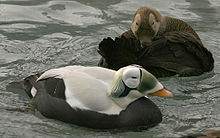Spectacled Eider
| Spectacled Eider | |
|---|---|
 | |
| Male (front) and female (rear) | |
| Conservation status | |
| Scientific classification | |
| Kingdom: | Animalia |
| Phylum: | Chordata |
| Class: | Aves |
| Order: | Anseriformes |
| Family: | Anatidae |
| Subfamily: | Merginae |
| Genus: | Somateria |
| Species: | S. fischeri |
| Binomial name | |
| Somateria fischeri (Brandt, 1847) | |
The Spectacled Eider (Somateria fischeri) is a large sea duck that breeds on the coasts of Alaska and northeastern Siberia.
The lined nest is built on tundra close to the sea, and 5–9 eggs are laid. This species dives for crustaceans and molluscs. The winter range is poorly known, but satellite tracking has led to observations of large flocks of the birds about 100 km southwest of St. Lawrence Island in the Bering Sea during March-April. This area has large populations of bivalves in the underlying sediments at depths of about 60 m that the ducks dive to feed on.
The Spectacled Eider is slightly smaller than the Common Eider at 52–57 cm in length. The male is unmistakable with its black body, white back, and yellow-green head with the large circular white eye patches which give the species its name. The drake's call is a weak crooning, and the female's a harsh croak.
The female is a rich brown bird, but can still be readily distinguished from all ducks except other eider species on size and structure. The paler goggles are visible with a reasonable view and clinch identification. Immature birds and eclipse adult drakes are similar to the female.
The Spectacled Eider is listed in the US as a Federally Threatened species and is unhuntable.
The binomial commemorates the German scientist Johann Fischer von Waldheim.


No comments:
Post a Comment